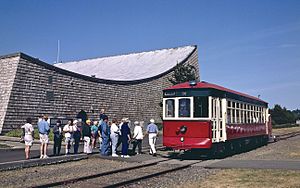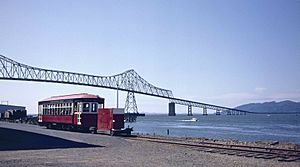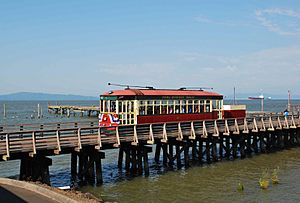Astoria Riverfront Trolley facts for kids
Quick facts for kids Astoria Riverfront Trolley |
|
|---|---|

Passing through the north end
of downtown Astoria in 2012 |
|
| Overview | |
| Status | Operating |
| Locale | Astoria, Oregon, United States |
| Termini | West End Mooring Basin/Astoria Riverwalk Inn East End Mooring Basin (39th Street) |
| Service | |
| Type | Heritage streetcar (tram); seasonal operation |
| Operator(s) | Astoria Riverfront Trolley Association |
| Ridership | Approx. 35,000—40,000 per season |
| History | |
| Opened | 1999 |
| Technical | |
| Line length | 3 miles (5 km) |
| Number of tracks | 1 |
| Track gauge | 4 ft 8 1⁄2 in (1,435 mm) |
| Electrification | None; electricity supplied by portable diesel generator |
The Astoria Riverfront Trolley is a fun, old-fashioned streetcar ride in Astoria, Oregon, United States. It runs for about 3-mile (4.8 km) along the Columbia River. This special trolley uses old train tracks. It doesn't have overhead power lines like some trolleys. Instead, it uses a portable diesel generator.
The trolley started running in 1999. It uses a streetcar built way back in 1913. This streetcar came all the way from San Antonio, Texas. The trolley is very popular. About 35,000 to 40,000 people ride it each year. It has become a well-known symbol of Astoria. The trolley usually runs from May through September. It also runs during spring break.
Volunteers from the Astoria Riverfront Trolley Association (ARTA) run the service. They also keep the streetcar and tracks in good shape. The city of Astoria has helped too. They provided money for a new building for the trolley. They also helped buy the streetcar. The car was first borrowed from San Antonio. But in 2005, ARTA bought it. By 2004, the trolley was one of Astoria's main attractions.
Contents
How the Trolley Got Started
People in Astoria first thought about having a historic streetcar in 1980. This was part of a plan to make the riverfront area better. Astoria used to have streetcars a long time ago, from 1892 to 1924. City leaders tried to get a trolley car in 1986. But it was too expensive because of high insurance costs.
In 1996, a railroad company stopped using its tracks in Astoria. The city of Astoria bought about 6 miles (10 km) of these tracks. This was so they could use them later. This idea is called "railbanking."
Astoria officials then found out about an old streetcar in Oregon. It was not being used. They were able to lease it for just $1 a year! This car was number 300. It used to run in San Antonio. Before coming to Astoria, it was used on another trolley line in Portland. In December 1998, car 300 moved to Astoria. It needed a lot of work because it had been stored outside.
Volunteers raised $40,000 to fix up car 300. They painted it red and green. They wrote "Astoria Riverfront Trolley" on its side. To save money, they didn't install overhead power lines. Instead, the trolley gets its power from a diesel generator. This generator is on a trailer that the trolley pulls or pushes.
The Trolley's Route and Service
The trolley started running on June 8, 1999. Its route was about 2.7-mile (4.3 km) long. The main place to get on was at the Columbia River Maritime Museum. At first, there were no other set stops. Later, they added more stops with benches and shelters. You can still wave down the trolley between stops.

The route goes along the Columbia River. You can see the river for most of the ride. In some spots, the tracks go over the water on low bridges called trestles. The trolley goes through the historic downtown area. It also passes under the big Astoria–Megler Bridge. East of the Maritime Museum, it passes an old train station built in 1924.
The fare has always been $1 for a single ride. You can buy an all-day pass for $2. Around 2006, the line got a bit longer. It now runs for about 3 miles (5 km).
The trolley usually runs daily from May through September. Sometimes it runs during spring break too. Hours are usually noon to 7 p.m. from Memorial Day to Labor Day. It has fewer hours in spring and fall. A full round trip takes about 50 minutes. The trolley runs about once an hour in each direction. There isn't an exact schedule.
Volunteers from the trolley group operate the car. There are two people: a motorman who drives, and a conductor. The conductor helps people get on at the back door. They collect fares and point out interesting sights. They also share stories about Astoria's history.
Local leaders say the trolley has helped make the downtown waterfront better. The mayor of Astoria once said the trolley "has become almost a logo for the city." He said it's second only to the Astoria Column as a city symbol.
Trolley Facilities and Purchases
In 2000 and 2001, benches and shelters were put at several stops. In 2002, a new building was built for the trolley. This building is called a carbarn. It's where the trolley car is stored and fixed. The city of Astoria owns this 4,000-square-foot (370 m2) building.
In 2005, the San Antonio Museum of Art agreed to sell car 300. The Astoria Riverfront Trolley Association (ARTA) bought it for $50,000. Most of the money came from donations. The city of Astoria also gave $5,000. The purchase was finished in early 2006.
In 2010, the trolley got a GPS tracker. This lets people see where the trolley is online. The information is updated every two minutes when the trolley is running.
History of Car 300

The Astoria Riverfront Trolley only has one streetcar, number 300. It's often called "Old 300." It was built in 1913 for the streetcar system in San Antonio, Texas. It ran there until 1933, when streetcar service stopped.
After that, a museum group in San Antonio got the car. In 1982, car 300 was fixed up. It started giving rides behind the art museum. This special service stopped in 1985 because of money cuts. "Old Number 300" went back into storage.
In 1990, car 300 came to Oregon. It was used on the Willamette Shore Trolley line in Portland until 1994. Then, it was stored at a museum near Gales Creek, Oregon.
In 1998, Astoria officials found out the car was available. They signed a five-year lease to use it. Car 300 came to Astoria in December 1998 to be restored. It started the Astoria Riverfront Trolley service in June 1999. In 2003, the lease was extended. But in 2005, ARTA bought the car outright.
See Also
- List of heritage railroads in the United States
- List of heritage streetcar systems in the United States


